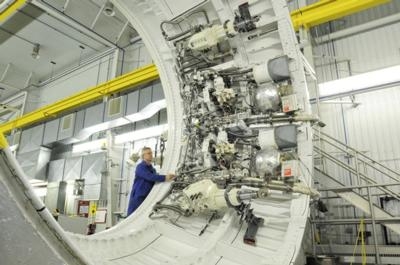Tue, Feb 05, 2013
ATK Says It Has Designed Affordability Into New Avionics Subsystem
The second in a series of development tests for NASA's Space Launch System (SLS) booster program was completed by NASA and ATK on January 30 at ATK's Promontory, Utah, test facility. This key avionics and controls test was designated Flight Control Test 2 (FCT-2) and included a "hot fire" of the fully integrated heritage thrust vector control (TVC), the new SLS booster avionics subsystem and new electronic support equipment (ESE).

FCT-2 focused on replacement of heritage test equipment with new ESE. Much of the equipment replaced was designed and built during the mid- to late-1970s and was successfully used on all Space Shuttle Reusable Solid Rocket Motor (RSRM) and five segment RSRM static motor firings.
"The FCT-2 test marked a definite milestone for ATK and NASA's SLS program," said Fred Brasfield, ATK's vice president, Next-Generation Booster. "Working with Marshall, we have designed and developed a modern system and common interface that allows for multiple uses of the same equipment at all necessary locations for both qualification and operational phases of the program, greatly reducing complexity and costs."
As with the avionics subsystem, affordability was designed in from the onset of developing new ESE. The same ESE design utilized to support static tests will also be used to support certification testing of the avionics subsystem in Utah and at NASA's Marshall Space Flight Center, and ultimately for acceptance check-out of flight hardware at Kennedy Space Center (KSC).
ATK developed the avionics subsystem at facilities in Clearfield and Magna, Utah, with support from NASA Marshall Space Flight Center in Alabama. Key partners supporting ATK throughout this test series include L-3 Cincinnati Electronics in Mason, Ohio, and Southern California Braiding, an IEC Electronics Company in Bell Gardens, California. Cincinnati Electronics provides the avionics boxes, and Southern California Braiding is responsible for the cable harnesses. Both Cincinnati Electronics and Southern California Braiding have been integral to ATK throughout the development lifecycle of the SLS booster.
"Our suppliers have been vital to the success of this program," said Brasfield. "They will remain key contributors through the SLS flight test program."
(Image provided by ATK)
More News
Light Gun A handheld directional light signaling device which emits a brilliant narrow beam of white, green, or red light as selected by the tower controller. The color and type of>[...]
"The journey to this achievement started nearly a decade ago when a freshly commissioned Gentry, driven by a fascination with new technologies and a desire to contribute significan>[...]
Aero Linx: JAARS, Inc. For decades now, we’ve landed planes on narrow rivers and towering mountains. We’ve outfitted boats and vehicles to reach villages that rarely se>[...]
"Our driven and innovative team of military and civilian Airmen delivers combat power daily, ensuring our nation is ready today and tomorrow." Source: General Duke Richardson, AFMC>[...]
Aircraft Conflict Predicted conflict, within EDST of two aircraft, or between aircraft and airspace. A Red alert is used for conflicts when the predicted minimum separation is 5 na>[...]
 ANN's Daily Aero-Term (04.20.24): Light Gun
ANN's Daily Aero-Term (04.20.24): Light Gun Aero-News: Quote of the Day (04.20.24)
Aero-News: Quote of the Day (04.20.24) ANN's Daily Aero-Linx (04.21.24)
ANN's Daily Aero-Linx (04.21.24) Aero-News: Quote of the Day (04.21.24)
Aero-News: Quote of the Day (04.21.24) ANN's Daily Aero-Term (04.21.24): Aircraft Conflict
ANN's Daily Aero-Term (04.21.24): Aircraft Conflict



